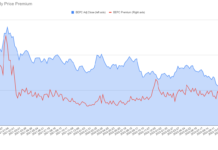Tom Konrad CFA
Volt owners are almost universally happy with their cars, despite the fact that very few will recoup the extra costs of the car in gas savings. Even though the financial savings are small compared to the large up front payment for the vehicle, the emotional payback more than compensates.
As someone who helps people invest in green stocks, I can tell you from first hand experience that investor enthusiasm has everything to do with recent financial returns, and not much to do with the good we’re doing.
In 2007, when practically any stock which could be labeled green was going stratospheric, my phone was ringing off the hook. Then came the crash in 2008, with green stocks falling more than the market as a whole. Worse, they failed to participate in the market recovery since then. Green investors are a dedicated lot. Many of my clients worried that the slump might never end, but none left. But the calls from new clients became very few and far between.
Finally, in late 2012, green stocks began to rally. The leading clean energy ETF, PBW, is up 40% from its November low. The leading solar ETF, TAN, is up 65% from its low.
The phone is ringing again.
Why the Difference?
To judge by the comments from Volt owners, their enthusiasm has a lot to do with the regular thrill they get driving by a gas station without stopping. Whenever they drive, they are reminded that they’re doing good for the environment. This makes them feel good, and that feeling keeps them feeling good about their cars, even without positive financial returns.
A green stock portfolio is different. Few investors make the emotional connection between their green stocks and the success of green companies.
Too Cerebral
Green money managers, in general, are not much help. I asked my panel of thirteen green money managers, ranging from investment advisors to hedge fund managers how buying green stocks helps green companies. Here is a sample of their responses:
Investment advisor Jan Schalkwijk, CFA at JPS Global Investments:
In theory, higher demand for green stocks – to which small investors would contribute by purchasing green stocks, mutual funds, and ETFs – should decrease the cost of capital for these companies, thus improving their ability to expand. Additionally, to the extent that the purchase is funded by a redemption of a non-green stock, this should increase the cost of capital for that company; thus reducing its scope for expansion. However, I don’t think small investors have enough clout to make this theory pan out in reality. It really requires big buy-in from large investors to make a dent.
Solar hedge fund manager Shawn Kravetz at Esplanade Capital:
[T]he small investor is in effect providing capital to the green company and depriving capital of other alternatives. While the green company has already raised the actual capital, the market purchase fuels demand for that sliver of ownership and in essence rewards the green company, making it easier and lower cost for them to raise more capital in the future and thereby spread their greenness. One investor does not move the needle per se, but the sum of multiple such investors indeed does.
That’s all true, but it does not exactly get the heart racing. Schalkwijk, Kravetz and I are immersed in the stock market on a daily basis. To us, moving the price of a stock a smidgen is very real, we do it and see its effects regularly. To the average small investor, however, this logic must seem hopelessly abstract.
Your Money, Direct to Clean Energy Projects
Fortunately, it’s not the whole story.
With the arguments for investing in green stocks so intellectual, it’s no surprise that even the most environmentally minded prospective investors are more interested in last month’s returns.
On Monday, I spoke to John Fullerton is the Founder and President of Capital Institute. The Capital Institute’s mission is to transform finance to effect a more sustainable economy. Its focus is on large institutional investors such as pension funds and endowments, but he agreed to speak with me about my personal focus: small investors.
In general, Fullerton thinks that the focus on trading in the stock market makes it very difficult for the sustainable investor to affect change. But he sees some exceptions. In particular, Master Limited Partnerships (MLPs) and REITs return their cash flows to investors, so they need to conduct secondary offerings (sell shares) whenever they make new investments. Investors in these vehicles are buying the future cash flows derived from the expansion of the enterprise, not just speculating on a future stock price.
At the moment, the MLP structure is limited to depleting resources such as fossil fuels and their transport, and so are not likely to be of interest to green investors. However, the MLP Parity Act, which was designed to correct this imbalance, has been re-introduced in the Senate with bipartisan support. If the act passes, small investors will have the opportunity to invest in publicly traded MLPs which will directly use the money to fund solar, wind, geothermal, and other clean energy projects.
For now, there are two publicly traded REITs investing in clean energy projects. The larger of the two is Hannon Armstrong Sustainable Infrastructure (NYSE:HASI), which went public last month and is investing the proceeds in eight clean energy projects that it had lined up in preparation for the IPO. Since Hannon Armstrong is a leading financier of clean energy projects, investors can be confident that secondary offerings to fund other projects are not too far in the future. By buying and holding HASI, they increase the amount of money the company can raise for new projects with a fixed amount of stock. The profits from those projects will then be returned to the investors as dividends.
With the second clean energy focused REIT, Power REIT (NYSE:PW), the connection between the small investor and the clean energy project they are financing is even more direct. Power REIT has just signed a term sheet for the
acquisition of 100 acres of California land underlying approximately 20MW of to-be-constructed solar projects for $1.6 million. PW will fund that purchase with a combination of debt and equity.
The equity will be raised by the company selling stock through a broker on the New York Stock Exchange under PW’s existing At Market Issuance Sales Agreement. In other words, if you buy the stock today, there is a good chance that the money won’t go to another investor; it will go straight to Power REIT to fund a solar farm. Even new investors who buy from other investors are directly helping by keeping the price up and ensuring that for every share PW sells as much money as possible helps finance the solar farm. Profits from the solar farm will then flow back to Power REIT and be returned to investors as dividends.
Venture Capital
Many small investors wanting to make an impact envy the venture capitalists (VCs) who can fund a start-up green technology company with a better battery or a more efficient wind turbines design.
They should not be jealous. VCs take their cues from the stock market, not the other way around. Without the stock market and the ability to sell a company to ordinary investors in an IPO, the only ways for venture capitalists to get a returns on their investments would be to sell them to other companies, or wait for the start up to generate enough profits to pay them back itself.
Many VC-backed companies are sold to other firms, but this is a second choice option, mostly used when stock market valuations are low. Waiting for a start-up to pay back its initial investors is simply not an option of VCs: the returns take too long. They prefer the money sooner, in five to ten years at most, so they can move on and fund the next promising start-up.
Because VCs count on IPOs for their best returns, they’re much more likely to fund start-ups in sectors with high valuations. When solar stocks are in the stratosphere, VCs fund solar start ups. When Smart Grid stocks are all the rage, VCs will be looking for the next great smart grid technology.
It’s not only First Solar’s (NASD:FSLR) management and shareholders who are paying attention to FSLR’s share price. It’s VCs, and all the entrepreneurs hoping to get those VCs to fund the next breakthrough solar technology.
We’re Invested in More Ways Than One
In addition to pointing out that buying a green company helps its stock price, Shawn Kravetz made another point:
[W]hen people own stocks they tend to patronize and talk about those companies. This vested interest and evangelism, when aggregated, does move the needle.
Fullerton makes a similar point in a recent blog post. He argues that we should understand investment in the context of a holistic decision-making process that seeks to harmonize (not trade off) financial, social, and ecological objectives.
Both are saying that it’s too simple to just look at the effect our investment are having on companies, we also have to consider the effect our investments have on us. People whose retirement depends on the continued profits of a coal companies are much more likely to give those companies a sympathetic ear when they complain that regulations to limit mercury emissions (or any other environmental harm) are too expensive and will undermine their profits.
If we invest in companies that stand to lose from the shift to a sustainable economy, the vested interests we are fighting are our own. Much better to invest ourselves, both financially and emotionally, in companies that will benefit from the changes we know must be made to protect our planet and our children.
Conclusion
Even the smallest investors’ green investments make a difference. This is most direct when they buy the shares of companies in the process of raising money for green investments. Yet they also makes a difference to a company’s ability to reward valuable employees with shares or options, and to the prospects of start-ups in similar industries. Higher prices for green stocks mean more green companies having successful IPOs, and more green start-ups secure funding.
Perhaps most important are the effects owning a slice of a green company has on the investor. It is much easier to make the right decisions for the planet and our future when we know the stocks we own will benefit from those decisions as well.
When green investors understand the very real changes their investments are having on the world, perhaps they’ll love their portfolios as well, like Volt owners love their cars.
Disclosure: HASI, PW
This article was first published on the author’s Forbes.com blog, Green Stocks on May 8th.
DISCLAIMER: Past performance is not a guarantee or a reliable indicator of future results. This article contains the current opinions of the author and such opinions are subject to change without notice. This article has been distributed for informational purposes only. Forecasts, estimates, and certain information contained herein should not be considered as investment advice or a recommendation of any particular security, strategy or investment product. Information contained herein has been obtained from sources believed to be reliable, but not guaranteed.








